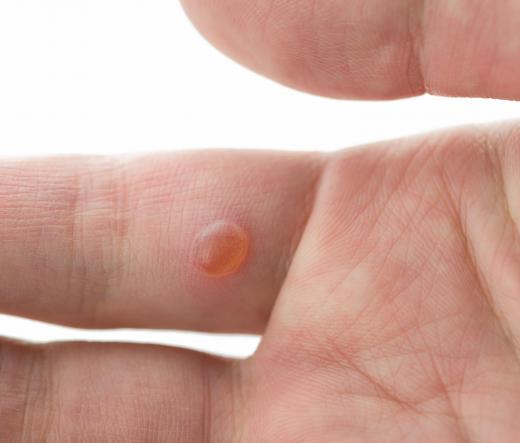What are Some Uses for Dry Ice?
Dry ice is another name for frozen carbon dioxide or CO2. It's often used in the food industry, where it can preserve perishable items and carbonate liquids. Dry ice can also be used to preserve medical specimens, freeze off warts, and even to get rid of some bugs.
Adding dry ice to any fruit juices or water will result in a sparkling drink. It's possible to prepare homemade root beer by adding it to root beer extract mixed with water. Dry ice also prevents the growth of bacteria, so it can be used to preserve dry seeds, grains, and flour and to retard baking yeast growth. Fruits frozen with this type of ice will thaw firm, not soggy. Campers have another use for it: they can keep food fresh for a longer period of time without having to worry about sogginess.
Another use for dry ice has to do with medicine, where it's commonly used to preserve and ship biological samples. Cosmetic surgeons use it to freeze warts for easy removal.

The "fog" used in entertainment special effects is made with dry ice. When it comes in contact with water, it condenses and forms a thick white fog. This can be effected with a fog machine or a simple deep metal plate. Because the substance can shrink metal, it's often used to pop out small dents and to shrink machine parts before assembly.
A lesser known use for dry ice has to do with keeping mosquitoes and wood beetles away. Mosquitoes are attracted to CO2 and naturally move towards the ice. Some pieces can be placed around a trap to keep mosquitoes away. Wood beetles can be eliminated from furniture by placing the piece inside a sealed freezer with several pounds of dry ice. The insects and eggs will suffocate within 24 hours.

Dry ice can be dangerous if not handled properly. With a temperature of -109.3°F (-78.5°C), it can severely burn the skin and cause suffocation if inhaled. The use of special gloves is highly recommended when handling this substance and, if working with it indoors, people should make sure the space is well ventilated.
AS FEATURED ON:
AS FEATURED ON:
















Discussion Comments
Have you felt dry ice? It is so cool. I don't think it is used to cool police cars because it is pretty expensive.
@anon336292: I'm going to assume your starting point would be somewhere in the United States. My rough guess is that it would take about 14 hours for a commercial airliner or UPS delivery plane to reach Japan, assuming it's a direct flight. The food items you described don't seem to require a deep freeze for survival, just refrigeration.
If you have a foam package large enough to carry those items, I would suggest placing a small layer of dry ice in the bottom of the package, then your items packed in metal boxes, then maybe another layer of dry ice if there was room on top. You're not trying to keep ice cream from melting or frozen steaks from spoiling, just some baked goods from getting too warm. A little dry ice and an insulated box should do it.
Be sure your food items are also wrapped in plastic to avoid any problems with condensation in the inner boxes. Dry ice sublimates from solid to gas, but the difference between the plane's air temperature and the temperature inside the box may trigger some condensation.
I need to know if dry ice can be used to send 7up cakes, rhubarb pies and cookies to Japan. If not, tell me how I can do this. I want to get this information before the holidays start.
I have successfully used dry ice to keep refrigerated and frozen goods stable in a broken refrigerator/freezer. It's important to keep the following in mind:
Dry Ice can be an expensive solution at $1 to $1.50/lb. 5 - 10 lbs/24hrs is what I needed.
The fridge/freezer doors must be kept closed as much as possible, obviously, to keep in the cold.
This next part I'm going to belabor a bit. Dry Ice sublimates directly into carbon dioxide gas, which can cause death very quickly through suffocation, and worse, causes drowsiness first. It will get your pets and small children before you notice a problem if in an enclosed space because it sinks to the floor and builds up from there as if it were a liquid. And you can't see it or smell it. For a gas, it's heavy, so opening a window may not get rid of it unless a solid breeze is blowing through. It's best to open doors to create a pathway for it to flow out of doors. It's much the same problem that can occur with volatile solvents like gasoline and paint thinner where the vapor crawls along the floor until it finds a pilot light or other ignition source, which then ignites all the standing vapor and the open container of solvent. Carbon dioxide, while behaving the same physically, will extinguish a flame, so, if you have a fridge in an enclosed basement near a water heater and the pilot light goes out you may have a dangerous situation on your hands. Find a way to ventilate such a room without going into it.
can dry ice be used to remove hail damage to cars?
Does anyone know the answer to no. 4 above? Can dry ice be used in a broken refrigerator to keep food from spoiling? If so, how long will the food be safe before spoiling? I am having a Thanksgiving dinner and my garage refrigerator just took a dump. I am looking for ways to make food in advance and keep it from spoiling since I won't have very much extra refrigerator space.
my fridge is broken and won't be fixed for a week. Can i use it to cool the fridge until then?
You couldn't keep a van cool with dry ice because when dry ice sublimates, it replaces oxygen. So everyone in the van would suffocate.
Does anyone know if FBI or police agents on stakeouts use dry ice to keep their van cool?
In Poultry farms, during hot summer months, is it possible to reduce the temperature inside open sheds by using Dry Ice.
Alternately, could anyone suggest an alternative method.
Post your comments